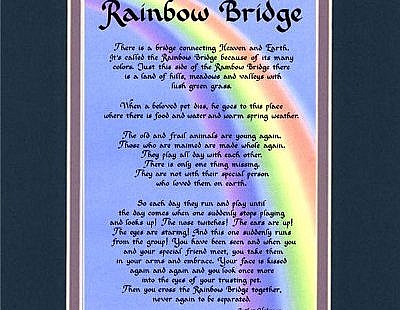After a pet dies, you may not know what to tell your children. These five tips for telling kids about pet loss are from Letting Go of an Animal You Love: 75 Ways to Survive Pet Loss. It’s my ebook; I interviewed pet loss experts, grief counselors, and veterinarians for the healthiest tips for grieving the death of a beloved dog or cat.

Help Children Cope With a Pet’s Death
Lifetimes: The Beautiful Way to Explain Death to Children by Bryan Mellonie and Robert Ingpen will help you learn how to talk about dog death with your children. It may feel unnatural and awkward at first, but it will get easier.
And here’s one of my favorite quotes about grieving loss: “Grief is like the ocean; it comes in waves ebbing and flowing. Sometimes the water is calm, and sometimes it is overwhelming. All we can do is learn to swim.” ~ Vicki Harrison.
This is the most bewildering aspect of mourning: some days we’re fine, and other days we’re a puddle of tears! It’s normal for grief to come and go – and that’s something kids should know about pet loss.
Helping Kids Cope With Pet Loss
The following story was suggested by grief counselor Marty Tousley – it was based on a story she found in Bereavement Magazine, called “Throwing Away the Wrapper” by Bob Willis.
A mother was trying to explain to her young son Ben what had happened to his beloved dog Raisin after she died. As he was getting ready for bed one night, the boy asked his mother, “Where is Raisin now?”
When she explained to him that his dog had died, the boy asked again, “But where is Raisin now?”
Suddenly aware of how helpless she felt to explain, the mother answered,
“Raisin is in Heaven.”
With this little Ben seemed satisfied, and he quietly went to bed. Next day, when Ben went out in the backyard to visit Raisin’s grave, he saw the grave site covered with flowers. He looked up at his mother and asked, “Is this Heaven?”
Again Ben’s mother was at a loss to explain the difference between Raisin’s being in Heaven and visiting Raisin’s grave. That night, as she tucked her son in bed, she took a chocolate candy bar from her pocket, carefully removed the wrapper, broke off a chunk and handed it to her son. “Let’s talk about Raisin,” she said. “Tell me what good memories you have of Raisin.”
The boy’s eyes brightened as he told how he’d gone exploring by the river with Raisin, took her to bed with him every night, and played fetch and chase games with her in the backyard. As he shared each happy memory, he munched contentedly on the rest of the candy bar.
When he’d finished with the good memories of Raisin and the candy bar, his mother pulled him close and hugged him. “Honey,” she said, “your dog Raisin is a lot like this candy bar. You know the good, delicious, wonderful and enjoyable part of Raisin that you remember? That’s the part of Raisin that’s in Heaven.”
Then she held up the empty candy bar wrapper. “This is the part of Raisin that’s buried in the ground — just Raisin’s wrapper.” A beautiful, peaceful look came over the little boy’s face as he realized what his mother was saying.
5 Ways to Help Children Cope With a Pet’s Death
One of the most important things to remember about kids and pet loss is that different children at different ages are affected in different ways.
“There is no right or wrong way to approach this sensitive subject,” says Marty. “But it’s important that, when a pet death happens or is about to happen, we explain things as openly and honestly as we can, at the child’s level of understanding.”
Let your child say goodbye to his or her lost pet
“[Saying goodbye] allows the first step of the grieving process to begin,” writes Lorri Greene in Saying Good-Bye to the Pet You Love. “Ask her if she wants to see the body, and respect her wishes. Some children may want to, and others may not. Let it be up to the child.”
If the pet’s death was gruesome, explain that Fluffy wouldn’t want to be seen that way. Saying goodbye can take many forms: a pet memorial ceremony in the backyard, unscheduled but regular times to reminisce fondly, children’s books and stories, and asking the veterinarian questions about death and the pet’s body. If you plan a memorial service or celebration, discuss where the pet’s remains should be buried. Make an appropriate marker. Decorate the grave. Encourage your loved ones to express love and respect at the time of the final goodbye.
Avoid euphemisms for pet death
“Explain what ‘dead’ means – that the animal’s body stops working and won’t work anymore,” says Marty, who wrote Final Farewell: Preparing for & Mourning the Loss of Your Pet. “Explain that death is not the same as sleeping, and avoid the common phrase for euthanasia (‘put to sleep’) as it can trigger sleep problems or intense anxiety over surgery and anesthesia.”
It’s better to say the pet was (or will be) helped to die peacefully and without pain. Marty also suggests not saying that the pet has “passed away”, “left us” or “gone on.” Those phrases imply the pet is on a trip and will return, may leave children feeling rejected or abandoned, or may encourage them to go searching for the lost pet or hold out hope for its return.
Be honest with your kids about the sadness that pet loss brings
“You can share your uncertainties, as well as what you know or surmise about death, but honest questions deserve honest answers,” writes Gary Kowalski in Goodbye, Friend: Healing Wisdom for Anyone Who Has Ever Lost a Pet. “Speaking to children openly and without equivocation about the end of life can help them develop trust in the mystery that surrounds us all.” Marty adds that grief is normal and necessary, and it’s fine to be sad in front of children. Say, “This is how we feel when someone we love dies.”
Stress that it’s the pet’s death (not something your children did or failed to do) that makes you sad. Say, “Mommy and Daddy are very sad because . . .”
Share your uncertainties about life after death
Show children your honest feelings about your pet’s passing – the good, the bad, and the ugly – so they’ll learn that emotions are valid and that it’s acceptable and healthy to mourn. “The ‘stiff upper lip’ false front sends kids the wrong message,” says Sid Korpi, author of Good Grief: Finding Peace After Pet Loss: Personal and Professional Insights on the Animal Lover’s Unique Grieving Process. “Instead, cry and express your sadness. They won’t view you as weak for crying over the loss; they’ll simply learn it’s safe for them to do so, too.”
Also, let them participate in planning a memorial service or ceremony. They can help you create a pet memorial headstone, plant a memorial tree, write a poem, or draw a picture to commemorate their pet. Your kids will learn how to grieve and survive pet loss from you – and that can be a good thing.
Visit online pet loss websites and blogs with your child
“Consider visiting online resources like Petrib.com to help you honor and remember your deceased pet,” says Sam Tharp, who lost her cat 15 years ago and still thinks of her regularly. “You can create a free tribute page, complete with photos and videos. The site was designed with children in mind – it’s colorful and user-friendly – to help them remember their pets in a positive way. There are also grief support forums where you share your loss with other pet owners that have experienced the death of a dog, cat or other animal ‘member of the family.’”
Choosing a beautiful cremation urn for your lost pet can also be a wonderful way to help kids cope with a pet’s death.





